
Cool? Not! Keen? Yessiree!
Small and Sensible -- the Echo rings clear for practical people
SEE ALSO: Toyota Buyer's Guide
By Larkin Hill
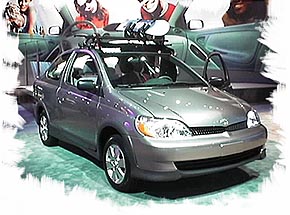 Toyota made a huge deal about this "Echo" being enhanced by a team of young "hip" designers. The Echo's supposed to be the next it thing for the "net-gen.". Hmmm, really?
Toyota made a huge deal about this "Echo" being enhanced by a team of young "hip" designers. The Echo's supposed to be the next it thing for the "net-gen.". Hmmm, really?
Amid flashing lights, smoke, and swingin' tunes, Toyota introduced their new it car to the US last winter at the 1999 North American International Auto Show. The style reminded me of the Prius, (Toyota's hybrid that's) because it was short, round, and had a distinctive Japanese Anime quality.
I remember back to the intro in Detroit when a 34 year-old American guy was introduced as being the head of a "young, hip, independent, and diverse 8-member group": the Genesis Group. Their job was to make the Echo a hip, cool, with-it car and introduce it to the techno-savvy "net-gen."
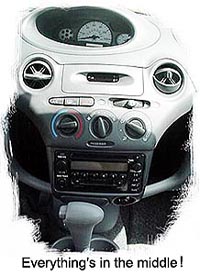 But if Toyota was hoping to just jump in and be cool with the Echo, they've got another thing coming -- regardless of how many swank details they add. It has a hood that's wider than it is long and a trunk that's taller than it is wide -- not exactly the ideal ingredients for a winning recipe. Both the four and two-door versions had a cute bubble in between the hood and trunk that's supposed to seat five people. It looked just plain goofy. Josie Grossie, from the movie Never Been Kissed, had a better chance at being popular than the Echo had at being considered "cool".
But if Toyota was hoping to just jump in and be cool with the Echo, they've got another thing coming -- regardless of how many swank details they add. It has a hood that's wider than it is long and a trunk that's taller than it is wide -- not exactly the ideal ingredients for a winning recipe. Both the four and two-door versions had a cute bubble in between the hood and trunk that's supposed to seat five people. It looked just plain goofy. Josie Grossie, from the movie Never Been Kissed, had a better chance at being popular than the Echo had at being considered "cool".
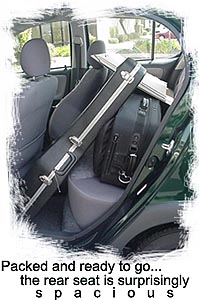
The Celica has the coolness factor, for sure. It's sharp, fast, agile, interesting, and it didn't hurt that Mitsubishi changed the Eclipse. The MR2 was less of a sure thing, but it definitely has future potential. But the Echo is a no-go.
So, what's the problem with the US "net-gen" and their lack of acceptance of the Echo? They're supposed to be tech-savvy, smart, affluent, and independent thinkers -- everything that the Echo is supposed to appeal to. The main problem is that Toyota assumed they were also sensible, practical, and efficient, and some are. However, what Toyota completely forgot was that they 're also image conscious, dynamic, and most of all -- not predicable.
Parents should like the Echo. They'll be the ones shelling out the cash, after all. But the reality is that they want to put their unpredictable kids into something bigger, sturdier, and more familiar. After all, they came from a time where bigger truly meant safer. Sure the Echo gets good gas mileage, is easy to use, and doesn't pack an engine that could send their kids to the moon. But the word "used" pops into my mind as a less expensive alternative to buying the kid something they really want.
So, who's buying the Echo? Sensible people, of course. It's a sensible car. For example, older generations that have been boxed into the "boat-car" category.
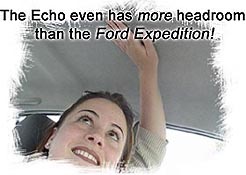 Why? For the same reasons the "net-gen" is all but ignoring them. They're simple to drive, economically priced, and best of all a cinch to get in and out of. It has enough room, has tons of storage space, and can squeeze into virtually any parking space imaginable. They're not necessarily buying them because of their futuristic style, hip attitudes, and independent thinking appeal, but because the Echo is safe, reliable, and comfortable.
Why? For the same reasons the "net-gen" is all but ignoring them. They're simple to drive, economically priced, and best of all a cinch to get in and out of. It has enough room, has tons of storage space, and can squeeze into virtually any parking space imaginable. They're not necessarily buying them because of their futuristic style, hip attitudes, and independent thinking appeal, but because the Echo is safe, reliable, and comfortable.
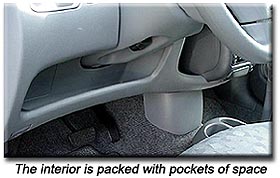
However, it's not just the older generations that are advocates for the Echo, commuters, environmentalists, and truly unique buyers that aren't just living for the image, are also shelling out the very practical price. "It's like driving a grown-up golf cart," enthused Marc Rauch, Executive VP of The Auto Channel, after running a quick errand across town. In fact, we had a hard time getting him out of it. It had excellent visibility, maneuverability, and gas mileage. It was just fun to drive -- playful and perky.
 In fact, everyone at the office who drove it thought it was great. Sure, it wasn't as slick as the Celica, but it definitely served its purpose. Despite its tiny stature, the Echo provided more than enough expendable space. It has more trunk space than its nearest competitor the Ford Focus (13.6 vs. 12.9 respectively), has a bit more headroom (39.9 vs. 39.3)
In fact, everyone at the office who drove it thought it was great. Sure, it wasn't as slick as the Celica, but it definitely served its purpose. Despite its tiny stature, the Echo provided more than enough expendable space. It has more trunk space than its nearest competitor the Ford Focus (13.6 vs. 12.9 respectively), has a bit more headroom (39.9 vs. 39.3)
The most controversial feature was the center mounted driver controls. Located smack-dab in the middle of the dash was the speedometer and engine warning lights (missing and missed was the tachometer). The reaction was not tepid -- either people liked it or they hated it.
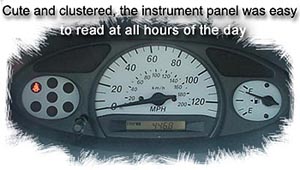 Ergonomically, the center location makes sense. Having everything centrally located improves ease of use because there's less strain on the eye. Instead of having to look up-and-right for the rear-view mirror, down-and-right for the stereo/air conditioning controls, front for the road, and down-and-center between-the-steering-wheel for the speedometer/gauges, the driver simply follows a line. This feature especially makes sense for the older generations because instead of trying to look down and focus between the steering wheel, they can simply glance to their right. I especially liked the fact that the speedometer remained in my peripheral vision.
Ergonomically, the center location makes sense. Having everything centrally located improves ease of use because there's less strain on the eye. Instead of having to look up-and-right for the rear-view mirror, down-and-right for the stereo/air conditioning controls, front for the road, and down-and-center between-the-steering-wheel for the speedometer/gauges, the driver simply follows a line. This feature especially makes sense for the older generations because instead of trying to look down and focus between the steering wheel, they can simply glance to their right. I especially liked the fact that the speedometer remained in my peripheral vision.
In fact, ergonomically, the entire Echo design is logical. Storage space is abounding, legroom is sufficient, and headroom is especially superior. The high seating position improves visibility, overall interior room, and makes getting in and out effortless. The buttons are large enough to see and close enough to reach with ease. Rear legroom was impressive, considering the overall tiny-ness of the Echo, and trunk space was aplenty.
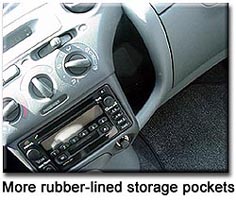
Mechanically the Echo also makes sense. The 1.5-liter four cylinder engine pumps out enough power to scoot the Echo across town safely and economically. Up hills, the Echo struggles, especially with two or more passengers and/or luggage. However, once shifted down, the Echo musters enough strength to conquer --although not quietly since the engine is working hard by that point.
The only thing people were unanimous on was the exterior styling. "Jelly-bean" and "peanut" were the two most popular affectionate names used. Most thought it looked goofy, silly, or stupid. It scored around a .59 (out of 10 points' possible) on the "cool" scale and it failed to attract many adoring glances. It definitely stood out in a crowd thought, and when the people 45 years old and up drove it, they received inquiries as to what it was. I received a couple, but they weren't envious of my pint-sized pedaler.
Yet, while the rear is too high, nose too short, and roof too tall for it's narrow frame, it receives and impressive .29 coefficient of drag. Again, the design is logical, despite how silly it looks.
Is it worth the $10,000 claim it costs? Well, that's a relative question. If you could really walk out the door for less than 10K, I'd be a deal -- no if's, and's, or but's about it. However, if you want the basic creature comforts like air conditioning and power steering, you're really talking close to 15K MSRP ($14, 265 to be exact for the 2-door). The 4-door we tested had a base price of $11,095 which was tested at $14, 964 (add $30 if you live on the East Coast).
Overall
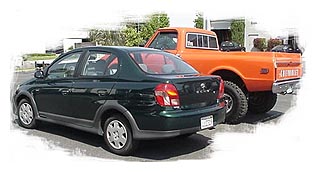 On it's own (sans the marketing jargon) the Echo is an excellent practical car. Personally, if I had that kind of money, I'd give it a miss and buy a used car -- probably a Corolla. However, for those who want a dependable, comfortable, zippy new car that'll keep its value, the Echo is a definite go.
On it's own (sans the marketing jargon) the Echo is an excellent practical car. Personally, if I had that kind of money, I'd give it a miss and buy a used car -- probably a Corolla. However, for those who want a dependable, comfortable, zippy new car that'll keep its value, the Echo is a definite go.